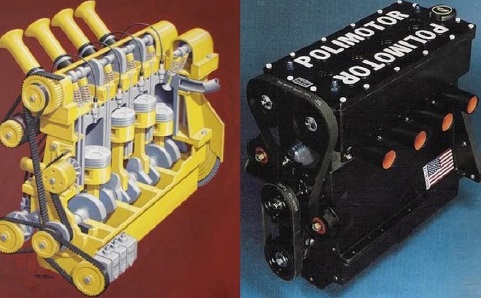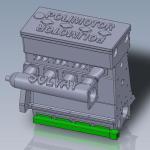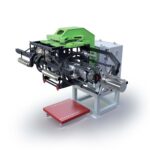Leading plastics companies are getting more involved with OEMs, from cars to medical devices, to help design lighter and stronger components and assemblies while also tweaking their own material formulations. Belgium-based Solvay is already known for its extensive work helping Solar Impulse 2 designers get their second 100% solar-powered plane off the ground earlier this year. Now, the plastics innovator is taking what it calls a leadership role in developing an all-plastic car engine, the Polimotor 2.
Version 2 of the Polimotor plastic engine is a four-cylinder, double-overhead CAM engine that will weigh between 138 lb and 148 lb (63 kg to 67 kg), or about 90 lb (41 kg) less than the standard, all- or mostly metal production engine in today’s cars.
A rendering of the Polimotor 2 all-plastic engine being designed and built by US engineer , which will include Solvay’s materials in 10 different parts.
A rendering of the Polimotor 2 all-plastic engine being designed and built by US engineer Matti Holtzberg, which will include Solvay’s materials in 10 different parts.
Working with the engine’s original designer, US engineer Matti Holtzberg, Solvay will replace up to 10 engine components usually made of metal with parts made from seven of its high-performing thermoplastic materials. The components include the oil pump, water pump, water inlet/outlet, throttle body, fuel rail, and cam sprockets, among others. Solvay says it contributed a major role toward the success of the first Polimotor engine, also conceived by Holtzberg, in the early 1980s.
Solvay plastics on the initial bill of materials for the new engine include the company’s Torlon polyamide-imide (PAI), Amodel polyphthalamide (PPA), KetaSpire polyetheretherketone (PEEK), AvaSpire polyaryletherketone (PAEK), Radel polyphenylsulfone (PPSU), Ryton polyphenylene sulfide (PPS), and Tecnoflon VPL fluoroelastomers.
The all-plastic Polimotor 2 engine will be installed in an M-20 C Coupe concept car from French race car designer and builder Norma Auto Concept, and raced competitively next year at the Lime Rock Park auto racetrack in Lime Rock, Conn.
In an article in Engine Labs, Holtzberg is quoted as saying he had already begun to work on a next-generation version of the Polimotor engine when Solvay approached him to restart the project. He says there that the new engine’s architecture will be the same as the original’s. What will be different are its new materials.
Photo’s 2 caption: US engineer Matti Holtzberg which designed and built Polimotor 2

















